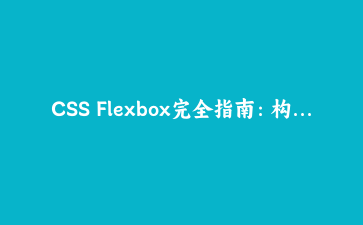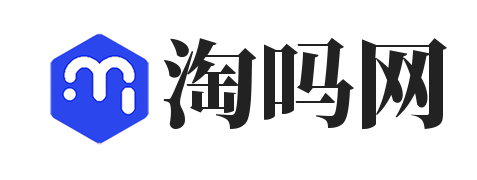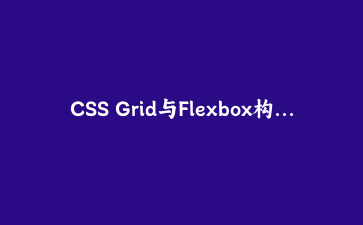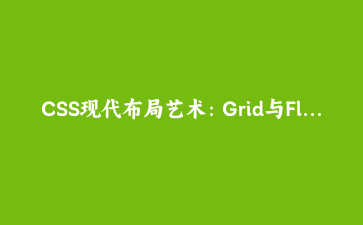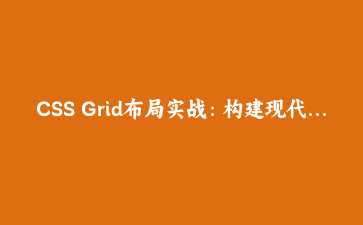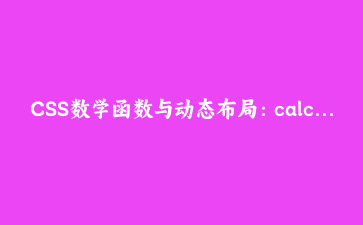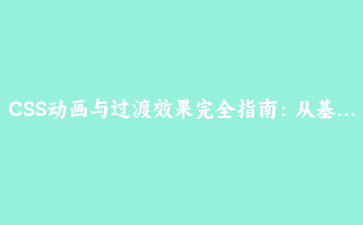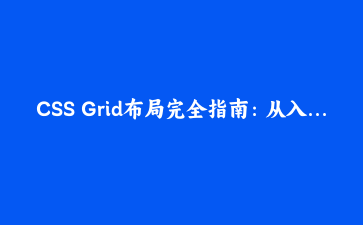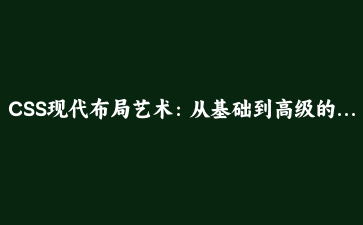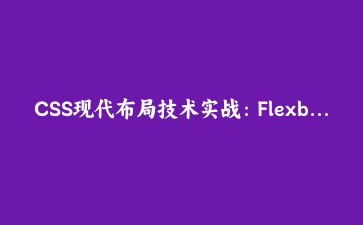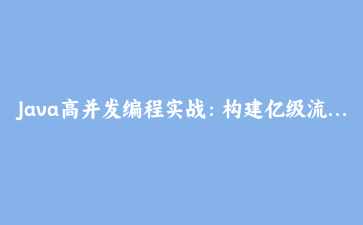一、Flexbox布局概述
Flexbox(弹性盒子布局)是CSS3中一种强大的布局模式,它提供了更加高效的方式来设计、布局和对齐容器中的项目,即使它们的大小是未知或动态的。
与传统的布局方式(基于盒状模型,依赖display、position和float属性)相比,Flexbox提供了更灵活的布局能力,特别适合构建响应式页面和小规模布局组件。
Flexbox设计目标:
- 在不同屏幕尺寸上提供更合适的布局分配
- 提供更简单、更灵活的布局方式
- 解决垂直居中这一经典CSS难题
- 使子元素能够在容器中自动伸缩
- 改变元素的显示顺序而不影响HTML结构
二、Flexbox基本概念
要理解Flexbox,首先需要掌握其核心概念和术语:
1. Flex容器 (Flex Container)
设置了display: flex或display: inline-flex的元素,成为Flex容器。
2. Flex项目 (Flex Items)
Flex容器的直接子元素自动成为Flex项目。
3. 主轴 (Main Axis) 和交叉轴 (Cross Axis)
Flexbox布局基于两个轴线:
- 主轴:由
flex-direction定义的方向 - 交叉轴:垂直于主轴的方向
4. 方向相关术语
- main-start | main-end:Flex项目从主轴的起点开始放置,到终点结束
- cross-start | cross-end:交叉轴的起点和终点
- main size:项目在主轴方向的宽度或高度
- cross size:项目在交叉轴方向的宽度或高度
三、Flex容器属性详解
1. display
定义一个Flex容器,可以是块级或内联的:
.container {
display: flex; /* 或 inline-flex */
}
2. flex-direction
定义主轴方向,即项目的排列方向:
.container {
flex-direction: row; /* 默认值:从左到右 */
flex-direction: row-reverse; /* 从右到左 */
flex-direction: column; /* 从上到下 */
flex-direction: column-reverse; /* 从下到上 */
}
3. flex-wrap
定义项目是否换行显示:
.container {
flex-wrap: nowrap; /* 默认值:不换行 */
flex-wrap: wrap; /* 换行,第一行在上方 */
flex-wrap: wrap-reverse; /* 换行,第一行在下方 */
}
4. justify-content
定义项目在主轴上的对齐方式:
.container {
justify-content: flex-start; /* 默认值:起始位置对齐 */
justify-content: flex-end; /* 结束位置对齐 */
justify-content: center; /* 居中对齐 */
justify-content: space-between; /* 两端对齐,项目间间隔相等 */
justify-content: space-around; /* 每个项目两侧间隔相等 */
justify-content: space-evenly; /* 项目间与边框间隔完全相等 */
}
5. align-items
定义项目在交叉轴上的对齐方式:
.container {
align-items: stretch; /* 默认值:拉伸填满容器高度 */
align-items: flex-start; /* 交叉轴起点对齐 */
align-items: flex-end; /* 交叉轴终点对齐 */
align-items: center; /* 交叉轴居中对齐 */
align-items: baseline; /* 项目的第一行文字基线对齐 */
}
6. align-content
定义多根轴线的对齐方式(当项目换行显示时):
.container {
align-content: stretch; /* 默认值:轴线占满整个交叉轴 */
align-content: flex-start; /* 交叉轴起点对齐 */
align-content: flex-end; /* 交叉轴终点对齐 */
align-content: center; /* 交叉轴居中对齐 */
align-content: space-between; /* 交叉轴两端对齐 */
align-content: space-around; /* 每根轴线两侧间隔相等 */
}
7. gap, row-gap, column-gap
控制项目之间的间距:
.container {
gap: 10px; /* 行和列间距都是10px */
row-gap: 15px; /* 行间距15px */
column-gap: 10px; /* 列间距10px */
}
四、Flex项目属性详解
1. order
定义项目的排列顺序,数值越小,排列越靠前:
.item {
order: 5; /* 默认值为0 */
}
2. flex-grow
定义项目的放大比例,默认为0(即如果存在剩余空间,也不放大):
.item {
flex-grow: 1; /* 等分剩余空间 */
}
3. flex-shrink
定义项目的缩小比例,默认为1(即如果空间不足,该项目将缩小):
.item {
flex-shrink: 0; /* 空间不足时也不缩小 */
}
4. flex-basis
定义在分配多余空间之前,项目占据的主轴空间:
.item {
flex-basis: 200px; /* 固定基础尺寸 */
flex-basis: auto; /* 默认值,项目本来的大小 */
flex-basis: 50%; /* 百分比值 */
}
5. flex
是flex-grow, flex-shrink和flex-basis的简写,默认值为0 1 auto:
.item {
flex: none; /* 相当于0 0 auto */
flex: auto; /* 相当于1 1 auto */
flex: 1; /* 相当于1 1 0% */
flex: 0 0 200px; /* 不放大、不缩小,基础尺寸200px */
}
6. align-self
允许单个项目有与其他项目不一样的对齐方式:
.item {
align-self: auto; /* 默认值,继承align-items */
align-self: flex-start; /* 交叉轴起点对齐 */
align-self: flex-end; /* 交叉轴终点对齐 */
align-self: center; /* 交叉轴居中对齐 */
align-self: baseline; /* 基线对齐 */
align-self: stretch; /* 拉伸填满容器高度 */
}
五、实战案例:创建响应式导航栏
HTML结构:
<nav class="navbar">
<div class="nav-brand">我的网站</div>
<ul class="nav-menu">
<li class="nav-item"><a href="#" rel="external nofollow" rel="external nofollow" rel="external nofollow" rel="external nofollow" rel="external nofollow" >首页</a></li>
<li class="nav-item"><a href="#" rel="external nofollow" rel="external nofollow" rel="external nofollow" rel="external nofollow" rel="external nofollow" >关于</a></li>
<li class="nav-item"><a href="#" rel="external nofollow" rel="external nofollow" rel="external nofollow" rel="external nofollow" rel="external nofollow" >服务</a></li>
<li class="nav-item"><a href="#" rel="external nofollow" rel="external nofollow" rel="external nofollow" rel="external nofollow" rel="external nofollow" >博客</a></li>
<li class="nav-item"><a href="#" rel="external nofollow" rel="external nofollow" rel="external nofollow" rel="external nofollow" rel="external nofollow" >联系</a></li>
</ul>
<div class="nav-toggle">
<span></span>
<span></span>
<span></span>
</div>
</nav>
CSS样式:
/* 导航栏容器 */
.navbar {
display: flex;
justify-content: space-between;
align-items: center;
padding: 1rem 2rem;
background-color: #333;
color: white;
}
/* 品牌标识 */
.nav-brand {
font-size: 1.5rem;
font-weight: bold;
}
/* 导航菜单 */
.nav-menu {
display: flex;
list-style: none;
margin: 0;
padding: 0;
gap: 2rem;
}
/* 导航项 */
.nav-item a {
color: white;
text-decoration: none;
transition: color 0.3s;
}
.nav-item a:hover {
color: #4CAF50;
}
/* 移动端菜单切换按钮 */
.nav-toggle {
display: none;
flex-direction: column;
cursor: pointer;
}
.nav-toggle span {
width: 25px;
height: 3px;
background-color: white;
margin: 3px 0;
transition: all 0.3s;
}
/* 响应式设计 */
@media (max-width: 768px) {
.nav-menu {
position: fixed;
left: -100%;
top: 70px;
flex-direction: column;
background-color: #333;
width: 100%;
text-align: center;
transition: 0.3s;
box-shadow: 0 10px 27px rgba(0,0,0,0.05);
padding: 2rem 0;
gap: 0;
}
.nav-menu.active {
left: 0;
}
.nav-item {
margin: 1rem 0;
}
.nav-toggle {
display: flex;
}
/* 汉堡菜单动画 */
.nav-toggle.active span:nth-child(1) {
transform: rotate(-45deg) translate(-5px, 6px);
}
.nav-toggle.active span:nth-child(2) {
opacity: 0;
}
.nav-toggle.active span:nth-child(3) {
transform: rotate(45deg) translate(-5px, -6px);
}
}
JavaScript交互(可选):
document.querySelector('.nav-toggle').addEventListener('click', function() {
this.classList.toggle('active');
document.querySelector('.nav-menu').classList.toggle('active');
});
六、实战案例:创建卡片网格布局
HTML结构:
<div class="card-container">
<div class="card">
<div class="card-header">
<h3>卡片标题</h3>
</div>
<div class="card-body">
<p>这里是卡片内容区域,可以包含文本、图片或其他元素。</p>
</div>
<div class="card-footer">
<button>操作按钮</button>
</div>
</div>
<!-- 更多卡片 -->
</div>
CSS样式:
/* 卡片容器 */
.card-container {
display: flex;
flex-wrap: wrap;
gap: 20px;
padding: 20px;
justify-content: center;
}
/* 单个卡片 */
.card {
display: flex;
flex-direction: column;
width: 300px;
border-radius: 8px;
overflow: hidden;
box-shadow: 0 4px 8px rgba(0,0,0,0.1);
transition: transform 0.3s, box-shadow 0.3s;
}
.card:hover {
transform: translateY(-5px);
box-shadow: 0 8px 16px rgba(0,0,0,0.2);
}
/* 卡片头部 */
.card-header {
padding: 1rem;
background-color: #4CAF50;
color: white;
}
.card-header h3 {
margin: 0;
}
/* 卡片主体 */
.card-body {
flex: 1; /* 使主体区域占据剩余空间 */
padding: 1rem;
background-color: white;
}
/* 卡片底部 */
.card-footer {
display: flex;
justify-content: flex-end;
padding: 1rem;
background-color: #f5f5f5;
border-top: 1px solid #eee;
}
.card-footer button {
padding: 0.5rem 1rem;
background-color: #4CAF50;
color: white;
border: none;
border-radius: 4px;
cursor: pointer;
transition: background-color 0.3s;
}
.card-footer button:hover {
background-color: #45a049;
}
/* 响应式调整 */
@media (max-width: 768px) {
.card-container {
flex-direction: column;
align-items: center;
}
.card {
width: 100%;
max-width: 400px;
}
}
七、Flexbox布局技巧与最佳实践
1. 垂直居中解决方案
使用Flexbox可以轻松实现元素的垂直居中:
.container {
display: flex;
justify-content: center; /* 水平居中 */
align-items: center; /* 垂直居中 */
height: 100vh; /* 容器高度为视口高度 */
}
2. 等高分栏布局
使用Flexbox创建等高的分栏布局:
.columns {
display: flex;
}
.column {
flex: 1; /* 所有栏目等分宽度 */
padding: 1rem;
background-color: #f0f0f0;
margin: 0 10px;
}
3. 圣杯布局实现
使用Flexbox实现经典的圣杯布局:
.body {
display: flex;
flex-direction: column;
min-height: 100vh;
}
.header, .footer {
flex: 0 0 auto;
padding: 1rem;
background-color: #333;
color: white;
}
.main {
display: flex;
flex: 1;
}
.content {
flex: 1;
padding: 1rem;
order: 2;
}
.sidebar {
flex: 0 0 200px;
padding: 1rem;
background-color: #f5f5f5;
}
.sidebar-left {
order: 1;
}
.sidebar-right {
order: 3;
}
4. 响应式表单布局
使用Flexbox创建响应式表单:
.form-group {
display: flex;
flex-wrap: wrap;
margin-bottom: 1rem;
}
.form-label {
flex: 0 0 150px;
padding-right: 1rem;
text-align: right;
}
.form-input {
flex: 1;
min-width: 200px;
}
@media (max-width: 600px) {
.form-label {
flex: 0 0 100%;
text-align: left;
margin-bottom: 0.5rem;
}
}
八、常见问题与解决方案
1. Flex项目宽度计算问题
当使用flex属性时,项目的实际宽度计算方式:
/* 项目的实际宽度计算方式: */
/* flex-basis + (剩余空间 × (flex-grow / 所有项目的flex-grow之和)) */
.item {
flex: 1 1 200px; /* 基础宽度200px,可伸缩 */
}
2. 最小内容大小问题
Flex项目默认不会缩小到其最小内容尺寸以下:
.item {
min-width: 0; /* 允许项目缩小到最小内容尺寸以下 */
overflow: hidden; /* 配合使用,防止内容溢出 */
}
3. 浏览器兼容性处理
虽然现代浏览器都支持Flexbox,但必要时可以使用@supports进行特性检测:
/* 首先提供传统布局作为备用 */
.float-layout {
float: left;
width: 30%;
margin: 0 1.5%;
}
/* 如果浏览器支持Flexbox,则使用Flexbox布局 */
@supports (display: flex) {
.flex-layout {
display: flex;
justify-content: space-between;
}
.float-layout {
float: none;
width: auto;
margin: 0;
}
}
九、总结
Flexbox是CSS中强大的布局工具,它彻底改变了我们创建网页布局的方式。通过掌握Flexbox,开发者可以:
- 轻松实现复杂的布局结构
- 创建完全响应式的设计
- 解决传统的CSS布局难题(如垂直居中)
- 提高开发效率和代码可维护性
虽然Flexbox主要用于一维布局(行或列),但它与CSS Grid(二维布局系统)结合使用,可以创建出更加复杂和灵活的布局结构。
建议在实际项目中多加练习,熟练掌握各种Flexbox属性和技巧,这将大大提高您的前端开发能力和效率。


